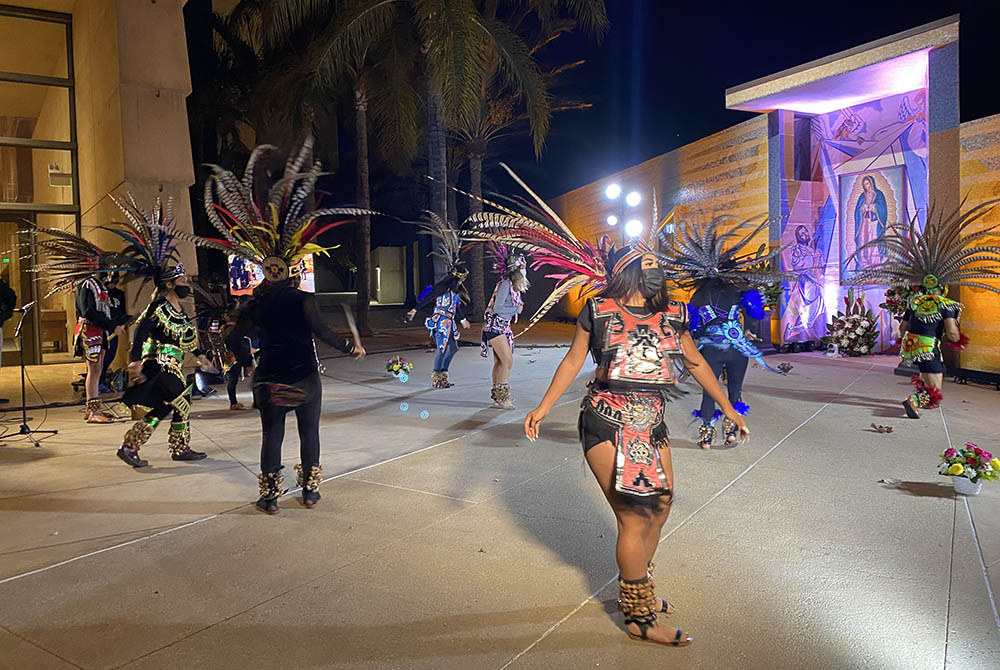
Aztec dancers wearing face masks honor Our Lady of Guadalupe in front of a shrine designed by artist Lalo Garcia in the courtyard of the Cathedral of Our Lady of the Angels in downtown Los Angeles. The performance, part of a Dec. 9 press event, was taped and will be included in the livestreamed Our Lady of Guadalupe celebration hosted by the Los Angeles Archdiocese beginning at 8 p.m. PST on Dec. 11. (NCR photo/Lucy Grindon)
The plan is for a flower-laden truck with speakers playing Guadalupana songs to carry an image of Our Lady of Guadalupe through North Hollywood today. Parishioners at St. Patrick's Catholic Church have been invited to decorate their homes with flowers and come out into their yards to welcome her, but their pastor, Fr. Nicolás Sánchez Toledano, is worried people may struggle to maintain social distance.
Sánchez, in an interview with NCR earlier this week, expressed concern that parishioners would greet Our Lady up close and bring flowers to lay on the truck at her feet instead of standing back beside their homes. "It's a very strong devotion," he said.
The theme of welcoming Our Lady of Guadalupe into individual homes is a prevalent one this year, as massively popular pilgrimages and processions have been canceled due to the COVID-19 pandemic. Pope Francis has even said Catholics can receive a plenary indulgence for at-home Guadalupan devotion (provided they attend an in-person Mass later, when it's safe).
The Basilica of Our Lady of Guadalupe in Mexico City hosts the world's largest Catholic pilgrimage every Dec. 11-12 as millions gather to celebrate the feast day that marks the appearance of Mary in December 1531 to St. Juan Diego, an Indigenous Mexican. It is a central devotion in Mexico, credited for galvanizing the growth of Catholicism beyond the Spanish colonizing elite, but this year's pilgrimage was canceled in November by Mexico's Episcopal Conference.
The second-largest Our Lady of Guadalupe pilgrimage is held annually at the Shrine of Our Lady of Guadalupe in Des Plaines, Illinois. Catholics from the Chicago area and from neighboring states travel for miles to the shrine. Last year, the Chicago Tribune reported that 200,000 pilgrims were expected. But that pilgrimage has been canceled this year, too.
The image of the Virgin is being temporarily removed from the shrine this morning and the campus is being shut down, said Alejandro Castillo, director of Hispanic communications for the Chicago Archdiocese. Castillo told NCR he's heard that some are planning to visit Our Lady in person before her image is removed, so taking it down before the actual feast day seemed like a necessary precaution. "We're doing this to protect them," he said. "We don't want this to be another superspreader event."
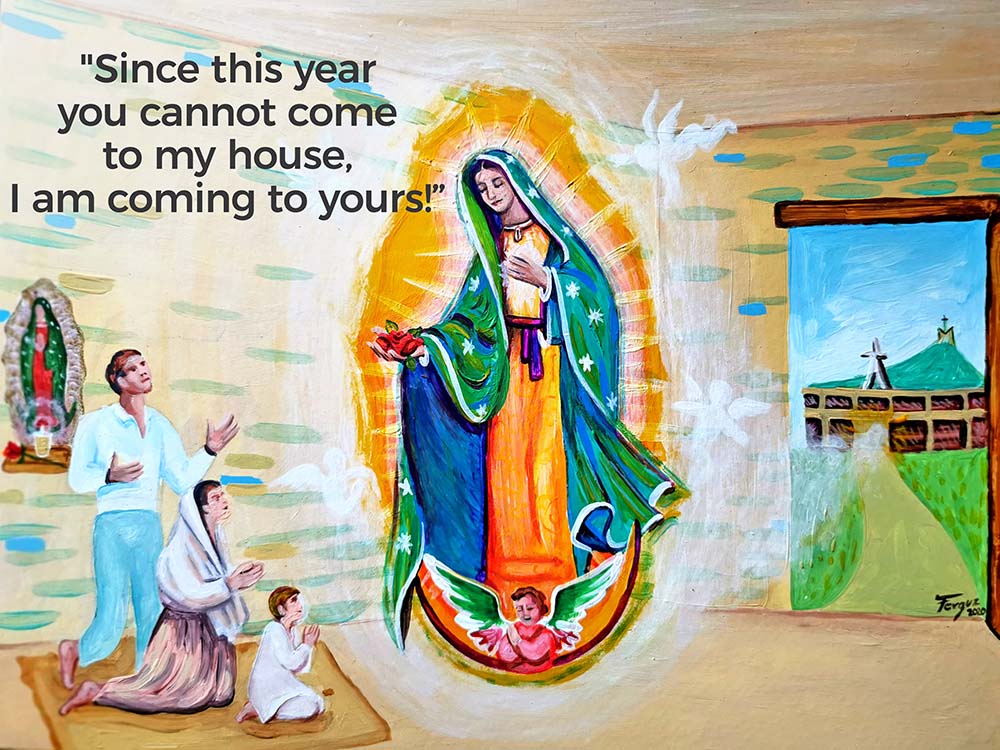
With the Basilica of Our Lady of Guadalupe closed for her feast to prevent the spread of COVID-19, Pope Francis said Catholics still can receive a plenary indulgence Dec. 11 and 12 for their Marian devotion if they follow certain conditions. (CNS illustration/TJ Birnbaum)
Fr. Manuel Padilla, an associate priest at the Des Plaines shrine, told NCR in an email, "Our topic this year is 'The Virgin of Guadalupe visits your home.'" Instead of welcoming pilgrims, the shrine will livestream Masses on Facebook.
Though giant gatherings like those usually held in Mexico City and Des Plaines are being replaced with livestreamed events, some local socially distanced outdoor gatherings and processions like the one at St. Patrick's are still taking place.
Christ the King Church, also in Los Angeles, has been holding outdoor Masses since July, the church's pastor Fr. Juan Ochoa told NCR. Attendance usually ranges from 80 to 200 people. (With social distancing restrictions in place, the church's parking lot can accommodate up to 300.) The feast of Our Lady of Guadalupe is popular with all the church's parishioners, the majority of whom are Filipino or Central American, Ochoa said. (Though she is most commonly associated with Mexico, Our Lady of Guadalupe is the official patron of the entire Americas, as well as the Philippines.)
On Dec. 12, Ochoa expects about 200 people to attend the feast day Mass. There will even be a mariachi band to honor Our Lady, as always, but no wind instruments. (Ochoa said a band typically has about 15 people, but with pandemic restrictions in place, the church can only let five or six perform at a time. Often, the band members all come from one household, and all must be masked except for the one person allowed to sing.)
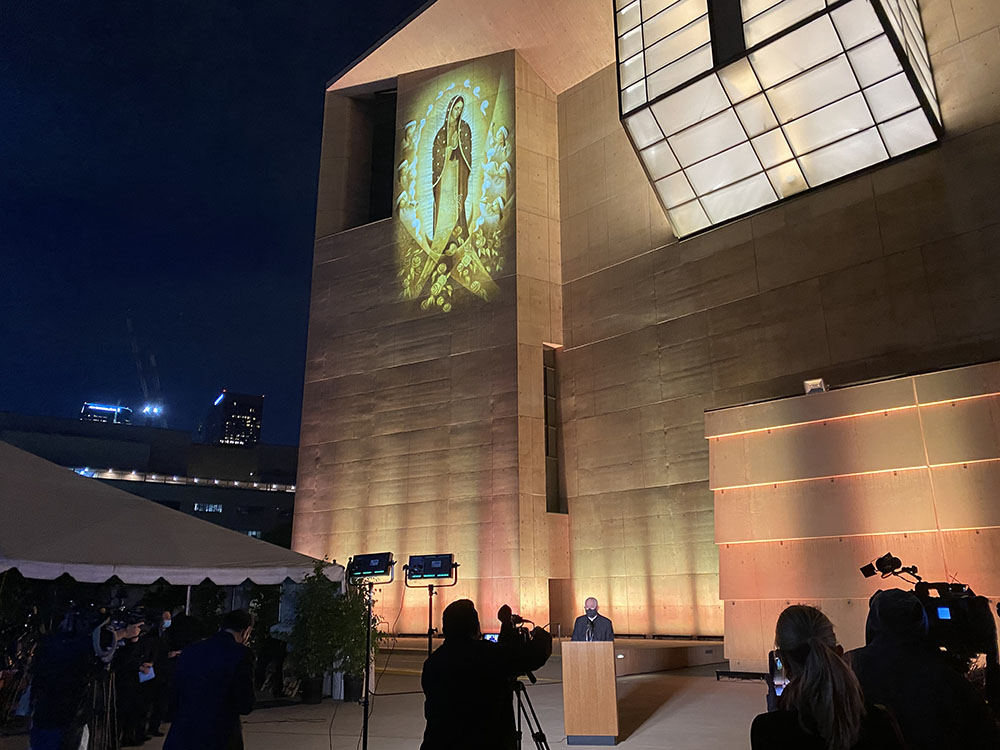
Archbishop José Gomez of Los Angeles offers a prayer at the Cathedral of Our Lady of the Angels in downtown LA during a press event Dec. 9, the feast day of St. Juan Diego, to whom the Virgin of Guadalupe first appeared in 1531. (NCR photo/Lucy Grindon)
As president of the Los Angeles Archdiocese's Guadalupano committee, Ochoa was responsible this year for adjusting both his parish's plans and the archdiocese's annual Our Lady of Guadalupe procession to fit COVID-19 restrictions set by the archdiocese, according to guidelines from the Los Angeles County Department of Public Health.
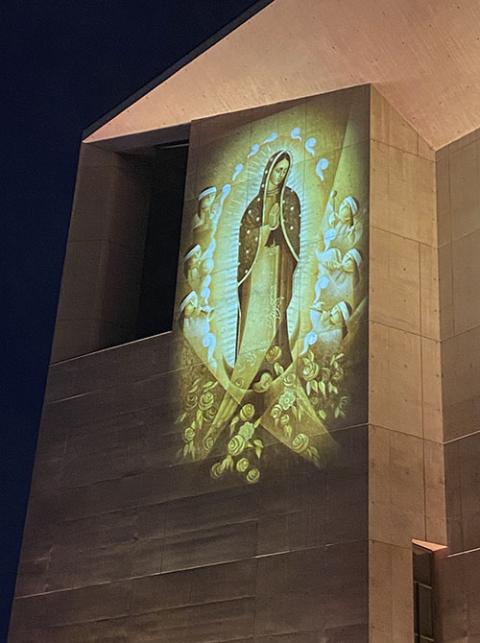
An image of Our Lady of Guadalupe painted by artist Lalo Garcia in 2013 is projected in light onto the outer wall of the Cathedral of Our Lady of the Angels in downtown Los Angeles, where it can be seen from the busy Hollywood Freeway. The painting, titled Cihualpilli Tonantzin (“Noble Little Indian, Our Mother”), depicts the Virgin of Guadalupe flanked by six angels playing Indigenous instruments. (NCR photo/Lucy Grindon)
In a normal December, thousands of Catholics would come from all over Southern California to participate in a procession through East Los Angeles, said Doris Benavides, a spokesperson for the Los Angeles Archdiocese. Because most parishes with significant Latino populations have their own celebrations on the actual feast day, Dec. 12, the diocese-wide procession is always held the weekend before, she said. This year, Ochoa said the Guadalupano committee decided to relocate the procession to the San Gabriel Mission and limit participation to a caravan of cars and a few people on foot, representing mostly Guadalupano families (those with a strong devotion to Our Lady of Guadalupe).
Amid the "fear and despair" of the pandemic, and particularly with the financial challenges faced by undocumented people who are not eligible to receive help from the government, Ochoa said, the church must take on the role of a mother and be there for her children. "We didn't plan just a procession or just a Mass," Ochoa said. "We had a much bigger purpose to bring hope to people."
In addition to the procession in San Gabriel last Sunday, the LA Archdiocese will livestream a Las Mañanitas celebration from the Cathedral of Our Lady of the Angels tonight, the eve of the feast day, with serenades from musicians, praying of the rosary, and a midnight Mass said by Archbishop José Gomez. In an ordinary year, Angelenos would gather en masse for the late-night celebration and worship. "This year there'll only be ten of us in the Cathedral, as opposed to about 3,000," said Fr. David Gallardo, the cathedral's pastor.
For the first time, the archdiocese is also honoring the Virgin by projecting her image in light onto the highest part of the Cathedral of Our Lady of the Angels, where it will be visible from the busy 101 freeway. "It's a way of letting those living in the local community — especially those travelling on the freeway — know that even during this time of pandemic, our spirit is not crushed, that we can still celebrate virtually for Our Lady of Guadalupe."
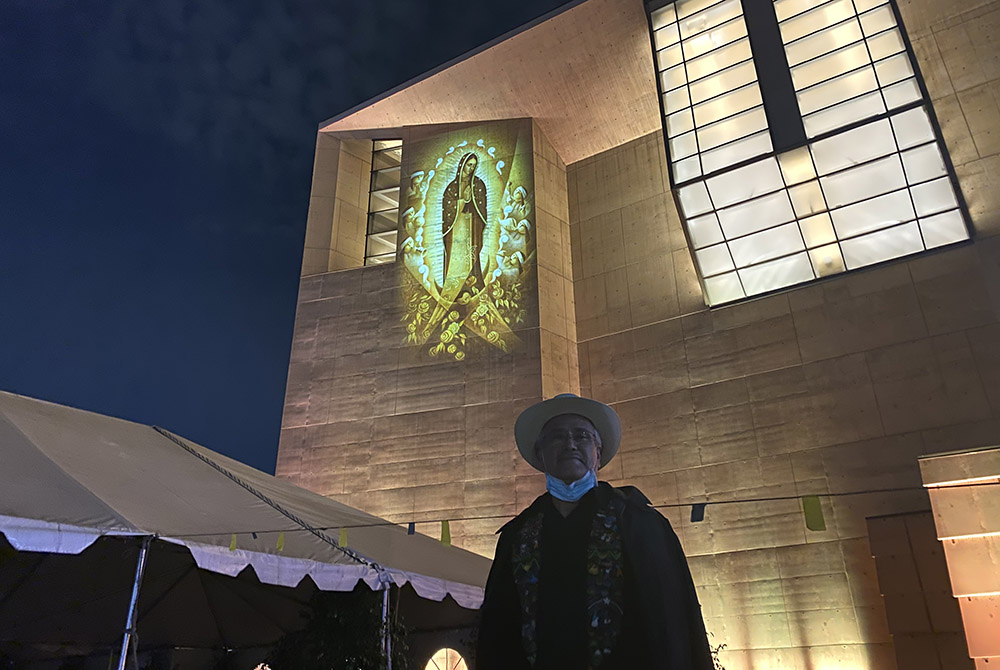
Artist Lalo Garcia stands in front of his 2013 painting of Our Lady of Guadalupe, Cihualpilli Tonantzin (“Noble Little Indian, Our Mother”), projected in light onto the outer wall of the Cathedral of Our Lady of the Angels, Dec. 9 in downtown Los Angeles. (NCR photo/Lucy Grindon)
Sacred artist Lalo Garcia, who painted the devotional image in 2013, hopes it will inspire devotion in those who see it. "I hope people will see her and not think about who created it. Especially during this hard time that we're going through, as we see the image hopefully we will all ask for her protection," Garcia said.
The Virgin of Guadalupe appeared to St. Juan Diego almost 500 years ago at a moment of chaos and despair, Ochoa said, when the world as Indigenous Americans knew it was completely falling apart. "She appears in that moment to bring hope — to bring a new vision to the people," Ochoa said. "Her hope is to recognize that, yes, today this is our situation, but if God intervenes, tomorrow will be different."
[Lucy Grindon is an NCR Bertelsen editorial intern based in Los Angeles. Her email address is lgrindon@ncronline.org.]
Advertisement





